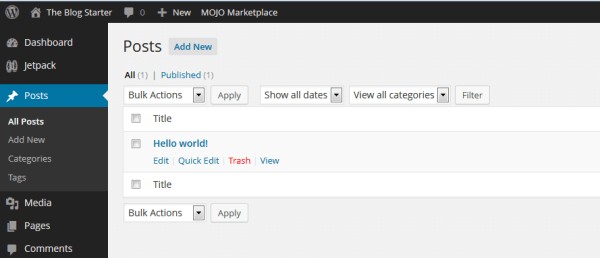Are you eager to share your voice and passions with the world? This comprehensive How To Start A Blog Guide will walk you through every step, from brainstorming a name to publishing your first post and beyond.
Whether you’re a complete beginner or have some technical experience, this guide is designed to be easy to follow and get your blog up and running quickly. Let’s dive in!
Should You Start a Blog? Exploring the Benefits
Many people hesitate, thinking they need to be expert writers. The truth is, blogging is about sharing your perspective, knowledge, and experiences in a relatable way. Here’s why starting a blog might be right for you:
- Share Your Unique Story: A blog provides a platform to express yourself, connect with others, and share your unique perspective on topics you care about.
- Earn Money Online: Blogging can be a lucrative side hustle or even a full-time career. With the right strategies, you can generate passive income by sharing your expertise.
- Become an Authority: A successful blog can establish you as an expert in your field, leading to recognition, opportunities, and new connections.
- Build a Community: Blogs foster interaction through comments and social media, creating a space for like-minded individuals to connect, learn, and share ideas.
What Exactly Is a Blog?
At its core, a blog is a website primarily focused on written content – blog posts. These posts are often written in a personal, conversational style, allowing bloggers to connect with their audience on a deeper level. The interactive nature of blogs, with comment sections and social sharing, fosters a sense of community and allows for direct engagement between the blogger and their readers.
Step 1: Choose a Captivating Blog Name
Your blog name is your online identity. It should be memorable, relevant, and easy to spell. Here’s how to brainstorm the perfect name:
- Reflect Your Topic: The name should give visitors an immediate understanding of what your blog is about.
- Keep it Short & Sweet: Aim for a name that’s easy to remember and type.
- Check Availability: Use a domain name checker to ensure your chosen name (and desired extensions like .com) are available.
What if Your Desired Name Is Taken?
Don’t despair! Here are a few options:
- Try a Different Extension: .net, .org, or .co can be good alternatives to .com.
- Add Descriptive Words: “The,” “My,” or “Best” can add uniqueness.
- Use Dashes: Separate words with dashes (e.g., cooking-blog.com).
Brainstorming Blog Topics and Names
If you’re unsure what to blog about, consider these ideas:
- Life Experiences: Share lessons learned from your personal journey.
- Hobbies & Passions: Write about what excites you, whether it’s cooking, travel, or a niche hobby.
- Personal Blog: Document your daily life, thoughts, and experiences.
Remember, a good blog name should be descriptive and give potential visitors a clear idea of your blog’s focus.
Can’t decide? Don’t hesitate to ask for help! Reach out to other bloggers or friends for feedback.
Step 2: Get Your Blog Online: Hosting and Software
Turning your blog name into a real website requires a few key components:
- Domain Registration: Securing your blog’s web address.
- Blog Hosting: A service that stores your blog’s files and makes it accessible online.
- Blogging Software: The platform you’ll use to create and manage your content. WordPress is the most popular option.
Bluehost: The Recommended Hosting Provider
Bluehost is a top choice for new bloggers for several reasons:
- Free Domain Name: They’ll register your domain name for free.
- Easy WordPress Installation: Automatic installation of WordPress simplifies the setup process.
- Reliable Hosting: Recommended by WordPress since 2005, hosting over 2 million blogs and websites.
- 24/7 Customer Support: Helpful support available via phone or chat.
- Money-Back Guarantee: 30-day money-back guarantee if you’re not satisfied.
 bluehost hosting
bluehost hosting
Setting Up Your Hosting Account
- Visit Bluehost: Go to Bluehost and click “Get Started Now.”
- Choose a Plan: The “Basic” plan is suitable for beginners.
- Enter Your Domain Name: Type in your desired domain and click “Search for Domain.”
- Create Your Account: Fill in your details and choose your hosting package options.
- Login to WordPress: After checkout, you’ll be logged into your Bluehost account. Click “Edit Site” to access your WordPress dashboard.
Step 3: Customize Your Blog’s Design
Your blog’s design is crucial for attracting and retaining visitors. WordPress offers incredible flexibility through themes.
Accessing the WordPress Dashboard
If you’re not already logged in, go to Bluehost and click “Login.” Once logged in, click the blue “WordPress” button to access your WordPress blog.
Changing Your Blog’s Theme
- Navigate to “Appearance” -> “Themes”: In the WordPress dashboard, find the “Appearance” tab on the left menu and click on it.
- Explore Available Themes: WordPress comes with pre-installed themes. To activate a theme, hover over it and click “Activate.”
- Install New Themes: Click “Add New Theme” to browse thousands of free themes.
Customizing Your Theme
Themes control the entire design of your blog. You can customize colors, fonts, layouts, and more. Many themes offer drag-and-drop functionality, making it easy to create a unique look.
Step 4: Write and Publish Your First Blog Post
With your blog set up and customized, it’s time to create content!
Creating a New Post
- Go to “Posts” -> “Add New Post”: In the WordPress dashboard, click “Posts” in the left menu and then click “Add New Post.”
- Add a Title and Content: Enter the title of your post in the top box and write your content in the lower box.
- Add Images: Click the “+” icon, select “Image,” and upload an image from your computer.
- Publish Your Post: Once you’re finished, click the “Publish” button in the top right corner.
Essential Content for Your Blog
Your blog should include both static and dynamic content:
-
Static Content: These are essential pages that remain relatively constant:
- About Me/Us: A biographical summary and mission statement.
- Contact Me/Us: A way for visitors to reach you.
- Disclaimer Page: Disclose any monetization methods.
- Privacy Policy: Required if you collect data from visitors.
- Terms of Service: Important if you sell products or services.
-
Dynamic Content: This is your blog and most important content in your blog. This is where you, as the creator, will infuse the blog with your brand of informative content that supplies your audience with knowledgeable tips, facts, opinions, and stories. This is how you engage your visitors and keep them coming back for more.
Writing Great Blog Content
Each post should be:
- Engaging: Use an alluring title and a compelling introduction.
- Informative: Provide valuable information and insights.
- Well-Structured: Use short paragraphs, headings, subheadings, lists, and images.
- Original: Create unique content based on your own knowledge and experience.
Publishing Your Blog
Once you’re ready to make your blog public, go to your WordPress dashboard, click “Home,” and then click “Launch your site.”
Step 5: Promote Your Blog to Attract Readers
Creating great content is only half the battle. You need to promote your blog to reach your target audience.
Effective Promotion Strategies
- Share with Your Inner Circle: Let your friends, family, and colleagues know about your blog.
- Leverage Social Media: Share your content on platforms like Facebook, Twitter, and Instagram.
- Engage with Other Blogs: Comment on relevant blogs in your niche.
- Interact with Your Visitors: Respond to comments and questions.
- Collaborate with Other Bloggers: Guest post on other blogs and partner with other bloggers.
- Post Regularly: Stick to a consistent posting schedule.
- Build an Email List: Collect email addresses to notify subscribers of new content.
- Optimize for Search Engines (SEO): Use relevant keywords, header tags, and categories.
Search Engine Optimization (SEO) Basics
- Header Tags: Use H1, H2, H3, etc., to structure your content.
- Categorization: Organize your content into relevant categories.
- Permalinks: Use descriptive and keyword-rich URLs.
Step 6: Monetize Your Blog and Earn Income
Once your blog gains traction, you can explore several ways to monetize it:
- Sell Advertising Space: Use Google Adsense to display ads on your blog.
- Affiliate Marketing: Promote products and earn commissions on sales.
- Sell Your Own Products and Services: Offer your own products, services, or digital downloads.
- Offer Memberships: Create exclusive content for paying members.
Remember that building a successful and profitable blog takes time and effort. Don’t get discouraged if you don’t see results immediately. Keep creating great content, promoting your blog, and engaging with your audience, and you’ll be well on your way to success!
Need More Help?
This how to start a blog guide provides a solid foundation for launching your blogging journey. For more detailed information and specific tutorials, explore additional resources and reach out to the blogging community for support. Happy blogging!
